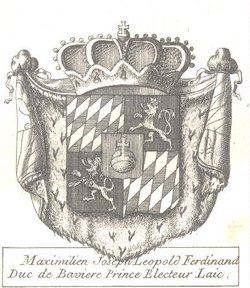Maximilian I, Elector of Bavaria
|
|
- Not to be confused with King Maximilian I of Bavaria (1756-1825), prince-elector of Bavaria (as Maximilian IV Joseph).
Maria_Anna_von_Bayern_(1610-1665)_black_white.jpg
Maximilian I, Elector and Duke of Bavaria (17 April 1573 – 27 September 1651), called "the Great,", was a Wittelsbach ruler of Bavaria and an prince-elector (Kurfürst) of the Holy Roman Empire. His reign was marked by the Thirty Years' War (1618-1648).
He was born in Munich, the eldest son of William V of Bavaria. He was educated by he Jesuits at the University of Ingolstadt, and began to take part in the government in 1591. He married in 1595 his cousin, Elisabeth Renata (also known as Elizabeth of Lorraine), daughter of Charles II, Duke of Lorraine, and became Duke of Bavaria upon his father's abdication in 1597. Only a few months after the death of Elisabeth Renata, Maximilian married, on the 15 July 1635 in Vienna, his only 25-year-old niece Maria Anna of Austria, the daughter of Ferdinand II, Holy Roman Emperor and his same-named sister (Maria Anna of Bavaria (1574-1616)). The main motivation for this swift remarriage was not so much political grounds as the hope of producing a prince to inherit. In contrast to the Elector's first wife, Maria Anna was very interested in politics and well instructed about developments. She was not bound to the Habsburgs, but rather completely advocated the Bavarian standpoint. Additionally, she conducted lively exchanges of opinion with high officials of the Munich court and took part in meetings of the cabinet.
By his second wife, Maria Anne, he left two sons, Ferdinand Maria, who succeeded him, and Maximilian Philip. In 1839 a statue was erected to his memory at Munich by Ludwig I, king of Bavaria. Weak in health and feeble in frame, Maximilian had high ambitions both for himself and his duchy, and was tenacious and resourceful in prosecuting his designs. As the ablest prince of his age he sought to prevent Germany from becoming the battleground of Europe, and although a rigid adherent of the Catholic faith, was not always subservient to the priest.
He refrained from any interference in German politics until 1607, when he was entrusted with the duty of executing the imperial ban against the free city of Donauworth, a Protestant stronghold. In December 1607 his troops occupied the city, and vigorous steps were taken to restore the supremacy of the older faith. Some Protestant princes, alarmed at this action, formed a Protestant Evangelical Union to defend their interests, which was answered in 1609 by the establishment of the Catholic League, in the formation of which Maximilian took an important part. Under his leadership an army was set on foot, but his policy was strictly defensive and he refused to allow the League to become a tool in the hands of the house of Habsburg. Dissensions among his colleagues led the duke to resign his office in 1616, but the approach of trouble brought about his return to the League about two years later.
Having refused to become a candidate for the imperial throne in 1619, Maximilian was faced with the complications arising from the outbreak of war in Bohemia. After some delay he made a treaty with the emperor Ferdinand II in October 1619, and in return for large concessions placed the forces of the League at the emperor's service. Anxious to curtail the area of the struggle, he made a treaty of neutrality with the Protestant Union, and occupied Upper Austria as security for the expenses of the campaign. On November 8, 1620 his troops under Count Tilly defeated the forces of Frederick, king of Bohemia and count palatine of the Rhine, at the White Hill near Prague.
In spite of the arrangement with the Union Tilly then devastated the Rhenish Palatinate, and in February 1623 Maximilian was formally invested with the electoral dignity and the attendant office of imperial steward, which had been enjoyed since 1356 by the counts palatine of the Rhine. After receiving the Upper Palatinate and restoring Upper Austria to Ferdinand, Maximilian became leader of the party which sought to bring about Wallenstein's dismissal from the imperial service. At the diet of Regensburg in 1630 Ferdinand was compelled to assent to this demand, but the sequel was disastrous both for Bavaria and its ruler.
Early in 1632 the Swedes marched into the duchy and occupied Munich, and Maximilian could only obtain the assistance of the imperialists by placing himself under the orders of Wallenstein, now restored to the command of the emperor's forces. The ravages of the Swedes and their French allies induced the elector to enter into negotiations for peace with Gustavus Adolphus and Cardinal Richelieu. He also proposed to disarm the Protestants by modifying the Restitution edict of 1629; but these efforts were abortive.
In March 1647 he concluded an armistice with France and Sweden at Ulm, but the entreaties of the emperor Ferdinand III led him to disregard his undertaking. Bavaria was again ravaged, and the elector's forces defeated in May 1648 at Zusmarshausen. But the peace of Westphalia soon put an end to the struggle. By this treaty it was agreed that Maximilian should retain the electoral dignity, which was made hereditary in his family; and the Upper Palatinate was incorporated with Bavaria. The elector died at Ingolstadt on September 27 1651.

